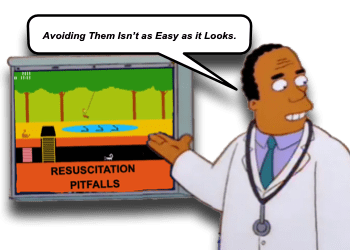Pediatric Resuscitation Pitfalls

Caring for children who present in distress is clearly challenging. There are innumerable conditions and entities to rapidly consider (ex, IEM, Heart Failure, Aortic Coarctation, Asthma, Hypoglycemia, Congenital Adrenal Hyperplasia, Thyroid Storm, … Occult Abdominal Trauma) while deftly taking critical actions (ex, Difficult Airway, Chest Compressions, Vascular Access). Fortunately, we are well trained and know how to quickly assess problems while concurrently stabilizing the unstable. Unfortunately, despite optimal education and vigilance, there are still several Pitfalls waiting for us to stumble into them (just like there are also Pediatric Trauma Pitfalls). Let us take a moment to reveal some common Pediatric Resuscitation Pitfalls:
Pediatric Resuscitation: Basics
Pediatric Arrest Statistics PMID:Wrong Shortcode Contents
- > 20,000 infants and children suffer a cardiac arrest each year in the US.
- ~11.4% of Pediatric Out of Hospital Cardiac Arrests (POHCA) will survive to hospital discharge.
- Only up to 47% of survivors will have favorable neurological outcomes.
- Cardiac arrest in infants and children does not usually result from a primary cardiac cause
- It is the end result of progressive respiratory failure or shock.
- Preceded by a variable period of deterioration, which eventually results in cardiopulmonary failure, bradycardia, and cardiac arrest.
AHA 2020 Updates
- The American Heart Association Guidelines for Cardiopulmonary Resuscitation were updated in 2020 PMID:Wrong Shortcode Contents
- 2010 highlights were discussed previously (yup… in 2010)
- The 2020 updates are NOT dramatically different… but had a few areas of focus.
- 2020 Areas of focus:
- High-Quality CPR is paramount !Optimize it!
- Adequate depth (1/3 AP diameter or > 5 cm)
- Appropriate rate (100 – 120 compressions/min)
- Full chest recoil
- Minimizing interruptions
- Avoiding excessive ventilation
- Defibrillation early when appropriate!
- 1st shock @ 2 J/kg, then 4 J/kg.
- Max dose = 10 J/kg or adult dose
- Initiate Epinephrine EARLY after CPR is started
- AS SOON AS POSSIBLE…. or in less than 5 minutes
- Obviously, requires access… don’t wait … place IO!
- 0.01 mg/kg (0.1 mL/kg) of the 0.1 mg/mL, with max of 1 mg.
- Use “cognitive aids” to assist with body weight estimation and dose determination!
- Airway & Breathing items:
- Respiratory Rate of 20-30 breaths per minute. (Higher than for adults)
- Bag-Mask Ventilation is reasonable to use during POHCA.
- Resuscitation with Bag-Mask Valve has same outcomes as with advanced airways.
- Supraglottic airway devise is consider an “advanced airway.”
- If using ETT, chose Cuffed ETTs over uncuffed (we knew this already, didn’t we?).
- Cricoid pressure does NOT reduce regurgitation and can obstruct airway. (we also knew this)
- Post-Return Of Spontaneous Circulation care is important.
- Target temperature management should be initiated for those who remain comatose.
- Avoid hypotension, hyperopia, hypoxia, hypercapnia, and/or hypocapnia!
- High-Quality CPR is paramount !Optimize it!
Pediatric Resuscitation Pitfalls to Avoid
- Deviations from the recommended pediatric resuscitation guidelines are common. [PMID 32057946: Wolfe, 2020]
- Wolfe et al. looked at >7,000 Pediatric In Hospital Cardiac Arrests (so not identical to POHCA), but the guidelines and tasks are similar.
- They identified several common deviations.
- Most common deviations were: [PMID 32057946: Wolfe, 2020]
- Airway Management
- Tracheal intubation DURING resuscitation was associated with decreased survival to discharge.
- Tracheal intubation during CPR is often the cause of poor quality CPR (which must be avoided). [PMID 26703462: Donoghue, 2016]
- AVOID THE PITFALL BY: Using BMV or Supraglottic Device!
- Medications
- Delay in administration of epinephrine is a well known issue.
- May be related to lack of access and/or uncertainty about dosage.
- AVOID THE PITFALL BY: Place IO right away and have references or color-coded tools. “Medicine is an open-book test.” – Dr. John Manning.
- Vascular Access
- Even in critically ill children, we are often reluctant to place an Intraosseous (IO) Needle. [PMID, 31806260: Lee, 2020]
- While CPR is associated with more rapid placement of IO needles in children (compared to critically ill patients not receiving CPR), the mean time to first attempt IO was still > 3 minutes.
- Delayed access (> 90 seconds) leads to delayed epinephrine administration.
- AVOID THE PITFALL BY: Don’t delay the IO placement. Your team can continue to look for other access points, but waiting for those to fail to then ask for the IO is TOO LATE.
- Airway Management
Moral of the Morsel
- Basic does not mean easy. Clearly deviations from the basics steps performed in a complex environment occur easily. Practice can help us perfect… so we should all find ways to “practice”… simulate makes us sensational!
- Kids are not aliens… Basics that work for adults also apply to children! High Quality CPR, Early Defibrillation, Early Administration of Epi, and Post ROSC management should be the focus.
- You can Intubate Later! I know… I know… everyone wants to intubate to protect that “A”irway, but BMV and Supraglottic airways are advanced airways and prevent CPR interruptions.
- Put the IO in now! You can always get other access also… but get the bone drill now.

